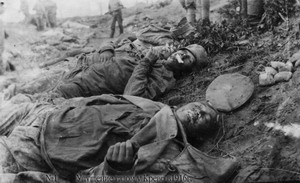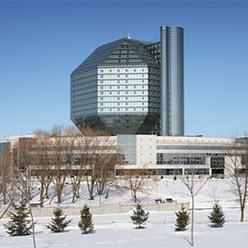
Operation in Krevo
 The last major operation of the Western Front took place in Krevo in June of 1917. It was held in other political circumstances – after the February revolution and the fall of the monarchy the power in the country devolved to the Provisional Government, the army was "democratized" (there were created committees that could cancel the order of the commander in every unit). The plan of this operation was an exact copy of the unrealized attack intended to be realized in the summer of 1916 in the direction of Ashmyany – Vilna. At the same time the 10th Army had to deliver the main blow. However, as the politicization of the army it became clear that the attack might fail but not because of the enemy’s invincible defensive line or lack of heavy shells, but by reason of the state of their own troops.
The last major operation of the Western Front took place in Krevo in June of 1917. It was held in other political circumstances – after the February revolution and the fall of the monarchy the power in the country devolved to the Provisional Government, the army was "democratized" (there were created committees that could cancel the order of the commander in every unit). The plan of this operation was an exact copy of the unrealized attack intended to be realized in the summer of 1916 in the direction of Ashmyany – Vilna. At the same time the 10th Army had to deliver the main blow. However, as the politicization of the army it became clear that the attack might fail but not because of the enemy’s invincible defensive line or lack of heavy shells, but by reason of the state of their own troops.
A. Denikin eloquently wrote about a real life of the army: "I reviewed the troops in line. However, in the corps of severe and firmly adhering to old discipline Dovbor-Musnitsky I saw the units preserved almost a normal, pre-revolutionary view as both in the outward forms and internal structure. Unfortunately, this case is an exception from the rule. I saw the majority of units which in spite of the fact that they had retained some semblance of order and obedience, their inner life looked like to the scattered anthill: after the troop review when I had passed ranks and talked with soldiers, I was just depressed because of the new mood that had gripped them – endless complaints, suspicion, distrust, resentment at everyone and everything :on a single chief and a corps commander, on lentils and a long stay at the front, on a nearby regiment and on the Provisional Government for its uncompromising attitude towards the Germans. I saw, at last, and such scenes that I wouldn’t forget for the rest of my days ... In one of the corps I ordered to show me the worst unit. I was taken to the 703rd Suramsky Regiment. We drove up to a huge crowd of unarmed people standing, sitting, wandering in the meadow outside the village. They were dressed in tattered rags (clothing was sold and drunken), barefooted, unshaven, unkempt, unwashed, – they seemed to have reached the highest degree of physical induration".
The offensive blow of the Western Front was constantly delayed – by the end of April, then 15 June, 22 June, 3 July, and, finally, 9 July, 1917. By the beginning of the offensive the composition of the forces of the Western Front had changed.
To understand the atmosphere in which the offensive was prepared, it is enough to mention that on 8 June the Congress of the Front Committee spoke out against the operation, on 18 June it spoke for it, but on 20 June it was again against. At the same time, other committees expressed their opinion. The Minsk Soviet of Workers’ and Soldiers’ Deputies decided not to conduct the attack, the 169th Division rendered a decision to consider the offensive as the betrayal of the revolution, and so on. All arrangements for the military operation actually fell on the shoulders of the officers who had to perform their direct duties and literally begged the soldiers to go on the offensive... It was everyday life of the Russian Revolutionary Army – "army of free Russia", as they used to call it then.
A huge number of artillery – 788 guns of which 356 is heavy-caliber – was generated in the area of the main attack for the break through the enemy’s strong defense line. The 38th Army Corps was the most equipped corp. All guns, apart from the 12-inch howitzers, had full ammo. Spotting was carried out by the 15th, 35th corps troops and the 11th Army aeronautic troop, the Grenadier troop, the 1st Siberian and the 34th corps aviation troops. It is worth to mention that the special units of the Russian army – artillery arms, air fleet, engineer detachments – were significantly less affected by the revolutionary expansion than the infantry forces, and so it was possible to rely on them.
A huge number of artillery – 788 guns of which 356 is heavy-caliber – was concentrated in the area of the main attack for the break through the enemy’s strong defense line. The 38th Army Corps was the most equipped corp. All guns, apart from the 12-inch howitzers, had full ammo. Spotting was carried out by the 15th, 35th corps troops and the 11th Army balloon troop, Grenadier troop, the 1st Siberian and the 34th corps aviation troops. It is worth to mention that the special units of the Russian army – artillery arms, air fleet, engineer detachments – significantly less affected by the revolutionary degeneration than the infantry forces, and so it was possible to rely on them.
But the operation in Krevo, lasted for a day – 9 July, ended in complete failure. 14 Russian divisions took part in the operation, but only 7 of them went on the attack and among them 4 divisions were combat-capable. The soldiers simply did not want to comply with the officers’ orders and went en masse to the rear area, shot at themselves – did everything trying to avoid the fight.
It is important and should be mentioned that one of the purposes of the Krevo operation has been achieved. This refers to the fact that for the first time in the history of trench warfare on the Western Front the troops of the 10th Army has partially destroyed and broken the enemy’s heavily fortified line of defense in the area of Krevo. Battles near Naroch and Baranovichy were a bitter lesson, and finally the right conclusions were drawn...


